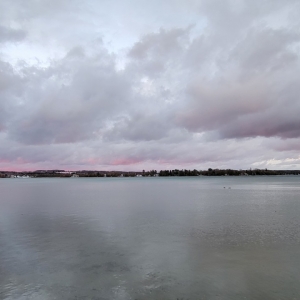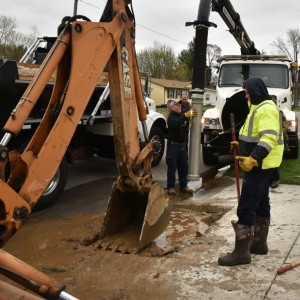Federal Water Tap, May 9: Interior Unveils Lake Powell Protection Measures
The Rundown
- To protect a shrinking Lake Powell, the feds will hold back more water and call in reinforcement supplies from upstream reservoirs.
- A Senate committee advances legislation to authorize Army Corps water projects.
- The GAO reviews the Department of Energy’s nuclear waste cleanups.
- Water bills introduced in Congress would set timelines for the EPA to issue PFAS regulations, authorize grant funding for tribal water and wastewater systems, and address farm runoff in the Great Lakes.
- The Army Corps begins a study of the vulnerability of Great Lakes shorelines to erosion and high water.
And lastly, the U.S. Environmental Protection Agency and Department of Justice revise their strategies for combatting pollution in low-income areas and communities of color.
“The Office of Environmental Justice will serve as the central hub for our efforts to advance our comprehensive environmental justice enforcement strategy. We will prioritize the cases that will have the greatest impact on the communities most overburdened by environmental harm.” — Merrick Garland, the attorney general, describing the goals of the Department of Justice’s new office. Garland also reinstated the use of “supplemental environmental projects” in settlement agreements with polluters. These projects help to offset the pollution burden in a community. The Trump administration generally prohibited use of this tool.
By the Numbers
20 to 0: Margin by which the Senate Committee on Environment and Public Works advanced a $24.6 billion bill to invest in water resources and infrastructure. Cycling through Congress every two years, the Water Resources Development Act authorizes Army Corps projects like ports, dam repairs, ecosystem restoration, erosion prevention, and reservoir improvements. The bill now goes to the full Senate.
News Briefs
Lake Powell Plan
The Interior Department will hold nearly an additional one million acre-feet of water in Lake Powell this year, a frantic attempt to bolster water levels in the shrinking reservoir and maintain its ability to generate hydropower.
The extra water comes from two places. About half is a 500,000 acre-foot reinforcement from Flaming Gorge, an upstream reservoir. The remaining 480,000 acre-feet is a reduction in flow. That water will not be released downstream to Lake Mead, which is also at a record low since it was first filled.
Tanya Trujillo, Interior’s assistant secretary for water and science, said the actions illustrate “the truly unprecedented challenges facing the Colorado River Basin.”
Interior claims that the extra water amounts to 16 feet of elevation in Lake Powell. Today the lake is 32 feet above the level at which hydropower generation is in doubt.
Water Bills in Congress
- The Tribal Access to Clean Water Act would authorize grant programs within three federal agencies to construct, operate, and maintain drinking water and wastewater facilities on tribal lands. The bill provides $500 million to the Indian Health Service for water system operation and maintenance; $500 million to the U.S. Department of Agriculture for construction; and $1 billion to the Bureau of Reclamation for rural water supply construction.
- The Great Lakes Agricultural Stewardship Act would establish a grant program within the U.S. Department of Agriculture to help farmers in the Great Lakes basin reduce polluted runoff from their fields. The bill authorizes $30 million over four years.
- The PFAS 2.0 Act would set two deadlines for the EPA: establish limits on PFAS concentrations in rivers and lakes, and regulate PFAS in industrial wastewater discharges. Both are items on the EPA’s PFAS “road map.”
Studies and Reports
DOE Waste Cleanup
The Government Accountability Office reviewed the Department of Energy’s environmental cleanup efforts.
Much of the work is repairing damage from the department’s nuclear program.
The GAO review focused on a subset of capital projects and operational activities at the department’s 16 active cleanup sites.
The biggest cost overruns are associated with the Hanford site, in Washington state. It is the largest and most expensive cleanup — an estimated $312 billion in capital and operating costs through the 2080s. A treatment facility is under construction for hazardous and radioactive waste that is a threat to groundwater and the Columbia River.
On the Radar
Great Lakes Shoreline Study
MLive reports that the Army Corps of Engineers is beginning a big-picture assessment of the vulnerability of Great Lakes shorelines to erosion and high waters.
The Army Corps says that a comprehensive look is necessary in order for the lakes to be managed effectively in a changing climate.
The $10.6 million study will be funded year-by-year. So far, Congress has appropriated $1.1 million. The eight states are on the hook for a quarter of the cost.
Congressional Hearings
On May 11, a Senate Appropriations subcommittee will hold a hearing on global food security. Witnesses include the executive director of the World Food Program.
Also that day the Senate Committee on Environment and Public Works hosts Brenda Mallory, the head of the Council on Environmental Quality, the White House office that oversees environmental reviews.
On May 12, a House Energy and Commerce subcommittee will discuss hydropower permitting.
Federal Water Tap is a weekly digest spotting trends in U.S. government water policy. To get more water news, follow Circle of Blue on Twitter and sign up for our newsletter.
Brett writes about agriculture, energy, infrastructure, and the politics and economics of water in the United States. He also writes the Federal Water Tap, Circle of Blue’s weekly digest of U.S. government water news. He is the winner of two Society of Environmental Journalists reporting awards, one of the top honors in American environmental journalism: first place for explanatory reporting for a series on septic system pollution in the United States(2016) and third place for beat reporting in a small market (2014). He received the Sierra Club’s Distinguished Service Award in 2018. Brett lives in Seattle, where he hikes the mountains and bakes pies. Contact Brett Walton






Leave a Reply
Want to join the discussion?Feel free to contribute!